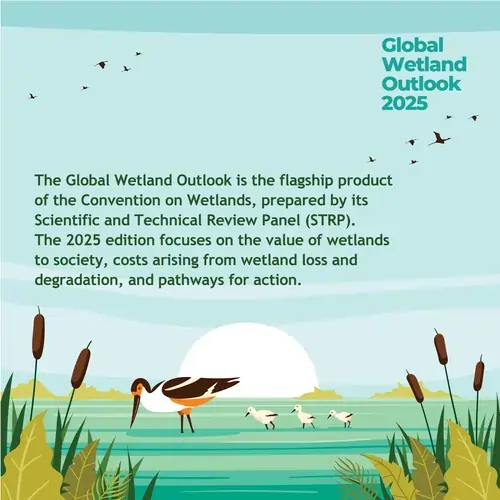New Delhi: Wetlands, critical ecosystems for biodiversity and climate stability, are disappearing at an alarming rate, with 22% lost since 1970, according to the Global Wetland Outlook 2025 (GWO). Released on July 15, 2025, by the Ramsar Convention Secretariat in Nairobi, the report warns that without urgent action, one-fifth of remaining wetlands could vanish by mid-century. Covering just 6% of Earth’s surface, wetlands provide ecosystem services worth $39 trillion annually, including water purification, carbon storage, and flood control.

The Global Importance of Wetlands
Wetlands, spanning 1,425–1,800 million hectares globally, include inland freshwater, coastal, and marine ecosystems. Despite their small footprint, they deliver services valued at 7.5% of global GDP, with African wetlands alone worth $825.7 billion in 2023. Since 1970, 411 million hectares have been lost, a 22% decline, at an annual rate of 0.52%. Wetlands are vital for water cycles, climate resilience, and billions of livelihoods, yet they receive less than 9% of climate finance for nature-based solutions.
“Wetlands are fundamental to the water cycle, to our global response to climate change, and to the wellbeing of billions,” said Hugh Robertson, chair of the Ramsar Convention’s Scientific and Technical Review Panel. The GWO emphasizes that wetlands in lower-income countries (LICs/LMICs), particularly in Africa, are in worse condition than in upper-middle-income or developed countries.
Africa’s Wetlands: Among the Most Degraded
Africa’s wetlands face severe degradation, with millions relying on them for food, water, and disaster protection. The GWO reports that Africa and Asia experience the most widespread deterioration, with South Africa’s wetlands degrading faster than restoration efforts can manage. Urbanization, industrial growth, and infrastructure development are the primary drivers in Africa, unlike North America and Oceania (invasive species) or Europe (drought).
The report notes that wetland condition correlates with economic status: least developed countries report more wetlands in poor condition, while developed countries report more in good condition. In Africa, this degradation weakens economies, increases climate vulnerability, and raises disaster response costs, particularly in nature-dependent economies where agriculture, forestry, and tourism contribute over 60% of GDP in some countries.
Key Threats to Wetlands
Unplanned urbanization, rapid industrial expansion, and infrastructure development are the leading causes of wetland loss in Africa, Latin America, and the Caribbean. These pressures often outpace conservation efforts, especially in LICs/LMICs. The GWO highlights that many impacts are not immediately visible, requiring field-based assessments to reveal the true extent of degradation. Globally, wetlands face additional threats from invasive species and drought, with 0.52% lost annually, undermining climate, biodiversity, and poverty alleviation efforts.
Transformative Solutions and Case Studies
The GWO proposes four pathways to reverse wetland loss:
- Integrating wetlands into national planning: Embedding wetlands in natural capital accounting to recognize their economic value.
- Embedding wetlands in climate and biodiversity finance: Increasing funding through innovative instruments like green and blue bonds.
- Recognizing wetlands’ role in the hydrological cycle: Prioritizing their contribution to water security and climate resilience.
- Mobilizing blended finance: Scaling up public-private investments for conservation and restoration.
Successful examples include Zambia’s Kafue Flats, where a $300,000 restoration project grew into a $1 million annual investment, supporting 1.3 million people and generating $30 million yearly from fisheries. The Regional Flyway Initiative, a $3 billion Asian partnership, restores over 140 wetlands critical to migratory birds and 200 million people. Seychelles’ pioneering “blue bond” demonstrates innovative financing for wetland conservation.
The report estimates that conserving and restoring 5.5 million square kilometers of wetlands—half Canada’s size—is essential to meet global biodiversity and climate targets. However, current funding, at 0.25% of global GDP, falls far short of requirements.
The Ramsar Convention and Global Efforts
The Ramsar Convention, established in 1971 and ratified by India in 1982, provides a framework for wetland conservation. Its strategic goals align with the Kunming-Montreal Global Biodiversity Framework (KM-GBF). The upcoming COP15 summit in Zimbabwe will leverage the GWO’s data to inform policy and legislative interventions. Evelyn Ndlovu, Zimbabwe’s environment minister, emphasized cross-border conservation, knowledge sharing, and community engagement.
“Restoring degraded wetlands could unlock massive socio-economic benefits for rural communities and accelerate Africa’s green transition,” said Musonda Mumba, Ramsar Convention secretary-general, during the report’s unveiling at the 20th African Ministerial Conference on the Environment (AMCEN-20) in Nairobi.
Economic and Social Impacts
Wetlands are economic engines, particularly for rural communities. Anthony Nyong of the African Development Bank highlighted that degrading wetlands increases climate vulnerability, reduces productivity, and raises disaster response costs. Conversely, investing in wetlands creates jobs, enhances food and water security, and builds resilience. The GWO underscores that wetland services, including flood control and food production, are often missing from national accounts, undervaluing their contribution.
Call to Action
The GWO 2025 calls for urgent, scaled-up investments to conserve and restore wetlands. “Wetlands remain overlooked in budgets, underrepresented in plans, and underfunded in action,” Mumba stated. The report’s release, days before COP15, aims to galvanize global action to halt wetland loss, emphasizing innovative financing and community-driven solutions.
FAQs
1. What is the Global Wetland Outlook 2025, and why is it significant?
The Global Wetland Outlook 2025 (GWO), released on July 15, 2025, by the Ramsar Convention Secretariat, is a comprehensive report detailing the state of global wetlands. It reveals that 22% of wetlands have been lost since 1970, with Africa’s wetlands among the most degraded. Its significance lies in highlighting wetlands’ critical role in biodiversity, climate resilience, and economic stability, providing $39 trillion in ecosystem services annually. The report proposes actionable solutions to reverse wetland loss, aligning with global biodiversity and climate goals.
2. What are the main threats to wetlands according to the GWO 2025?
The primary threats to wetlands, particularly in Africa, Latin America, and the Caribbean, include unplanned urbanization, rapid industrial growth, and infrastructure development. In North America and Oceania, invasive species are a major concern, while drought is the leading issue in Europe. These pressures contribute to an annual global wetland loss rate of 0.52%, with lower-income countries facing the most severe degradation.
3. How do wetlands contribute to the global economy and environment?
Wetlands cover just 6% of Earth’s surface but deliver ecosystem services worth up to $39 trillion annually, equivalent to 7.5% of global GDP. In Africa, wetlands are valued at $825.7 billion. They support water purification, carbon storage, flood control, food production, and livelihoods for billions. Wetlands are vital for climate resilience, water security, and biodiversity, yet they receive less than 9% of climate finance for nature-based solutions.
4. What solutions does the GWO 2025 propose to protect wetlands?
The GWO outlines four transformative pathways:
Mobilizing public-private finance to scale up conservation and restoration.
Successful examples include Zambia’s Kafue Flats ($1 million annual investment) and the $3 billion Regional Flyway Initiative in Asia, restoring 140 wetlands.
Integrating wetlands into national planning using natural capital accounting.
Embedding wetlands in climate and biodiversity finance through tools like green and blue bonds.
Recognizing wetlands’ role in the global hydrological cycle.
5. What is the Ramsar Convention, and how does it relate to the GWO 2025?
The Ramsar Convention, established in 1971 and ratified by India in 1982, is an intergovernmental treaty for wetland conservation and sustainable use. The GWO 2025, published by its Secretariat, informs its strategies, aligning with the Kunming-Montreal Global Biodiversity Framework. The report’s findings will guide discussions at the COP15 summit in Zimbabwe (July 23-31, 2025), aiming to drive policy and funding for wetland protection.

